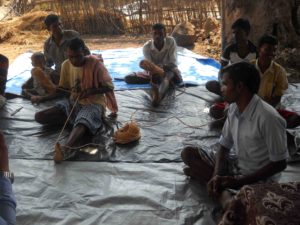A step towards their own forest for the Mankdia people of Simlipal in Odisha
 The Mankdia, Khadia and the Lodha communities are three classified Primitive and Vulnerable Tribal Groups (PVTGs) living in the Mayurbhanj district of Odisha. Such communities have been suffering from the deprivation of their entitlements. Their lack of confidence to claim their rights makes them inherently vulnerable; in addition, most Khadia and the Mankdia people are psychologically not so strong enough to deal with mainstream society. The Lodha community, on the other hand, suffers from the social stigma due to historical reasons but some of them are gradually adopting agriculture as their livelihood. Yet, for a majority of the PVTGs the forest is their mainstay and they choose to live close to them, especially in the Similipal Biosphere Reserve.
The Mankdia, Khadia and the Lodha communities are three classified Primitive and Vulnerable Tribal Groups (PVTGs) living in the Mayurbhanj district of Odisha. Such communities have been suffering from the deprivation of their entitlements. Their lack of confidence to claim their rights makes them inherently vulnerable; in addition, most Khadia and the Mankdia people are psychologically not so strong enough to deal with mainstream society. The Lodha community, on the other hand, suffers from the social stigma due to historical reasons but some of them are gradually adopting agriculture as their livelihood. Yet, for a majority of the PVTGs the forest is their mainstay and they choose to live close to them, especially in the Similipal Biosphere Reserve.
 The Khadia are known as hunter gatherers and collect various NTFPs through the year. They are also known for their honey hunting skills. The Mankdia collect, other than food, only the bark of siali creeper (Bauhnia vahli) for their income. Siali is found across the Similipal Biosphere Reserve but they are abundant in the denser forests as the creeper needs the support of big trees for their growth. The Mankdias use the bark to fashion ropes and some other articles. Of late, efforts have been made by Gram Swaraj, an NGO working in the region, to design other handicraft from the bark. For many years the Mankdia communities have faced restrictions in collecting the siali bark from the authorities of the Similipal Tiger Reserve; as they have few other options they continue with the practice for their livelihood.
The Khadia are known as hunter gatherers and collect various NTFPs through the year. They are also known for their honey hunting skills. The Mankdia collect, other than food, only the bark of siali creeper (Bauhnia vahli) for their income. Siali is found across the Similipal Biosphere Reserve but they are abundant in the denser forests as the creeper needs the support of big trees for their growth. The Mankdias use the bark to fashion ropes and some other articles. Of late, efforts have been made by Gram Swaraj, an NGO working in the region, to design other handicraft from the bark. For many years the Mankdia communities have faced restrictions in collecting the siali bark from the authorities of the Similipal Tiger Reserve; as they have few other options they continue with the practice for their livelihood.
The Forest Rights Act gave them an opportunity to affirm their traditional practice of forest use. A proactive Mayurbhanj district administration, Gram Swaraj, and Vasundhara, a Bhubaneswar-based NGO, came together to provide support to the Mankdia in the formal submission to their forest rights. In six administrative blocks of Mayurbhanj district, 255 Mankdia households live in nine habitations; the process of claims submission began at the village level, with  consultations and awareness-building in December 2015. Later, maps of their habitat, forest resources and their use, were also prepared. Very meticulously, the Mankdia people drew their territorial map which extended to Balasore and Keonjhar districts, beyond Mayurbhanj. They mentioned the names of different tracts of forests, routes, their meeting places, places of worship and resting, and water sources. Interestingly, none of the territories the various communities mapped overlapped with each other. Eventually, the habitat right claims documents were prepared and these maps incorporated. In a third phase, the verification of these claims were conducted by the forest and the revenue departments and then submitted to the Sub-Divisional Level Committees during last week of April 2016. It is expected that, very shortly, the habitat rights of the Mankdia people will be recognized by Divisional Level Committee of Mayurbhanj. Though the Mankdia are far behind in education and health, and suffer from poverty, malnutrition and a high mortality rate, the recognition of their habitat will be an historic step towards a dignified life.
consultations and awareness-building in December 2015. Later, maps of their habitat, forest resources and their use, were also prepared. Very meticulously, the Mankdia people drew their territorial map which extended to Balasore and Keonjhar districts, beyond Mayurbhanj. They mentioned the names of different tracts of forests, routes, their meeting places, places of worship and resting, and water sources. Interestingly, none of the territories the various communities mapped overlapped with each other. Eventually, the habitat right claims documents were prepared and these maps incorporated. In a third phase, the verification of these claims were conducted by the forest and the revenue departments and then submitted to the Sub-Divisional Level Committees during last week of April 2016. It is expected that, very shortly, the habitat rights of the Mankdia people will be recognized by Divisional Level Committee of Mayurbhanj. Though the Mankdia are far behind in education and health, and suffer from poverty, malnutrition and a high mortality rate, the recognition of their habitat will be an historic step towards a dignified life.
Author – Deepak Pani

